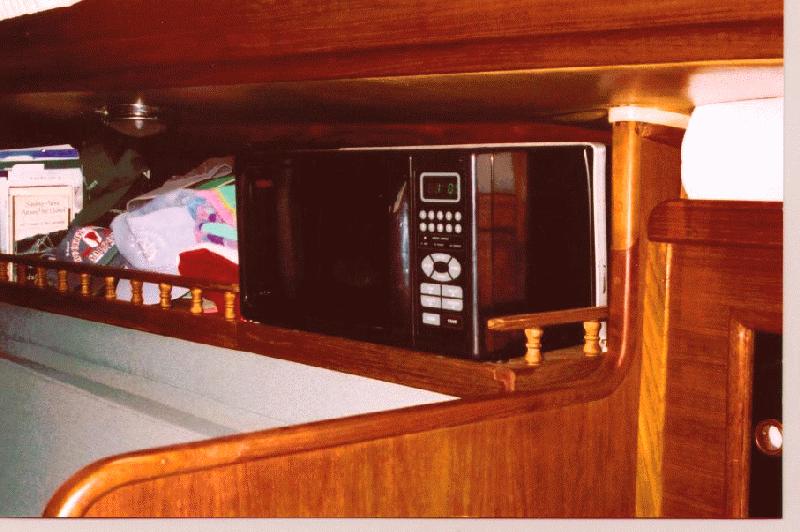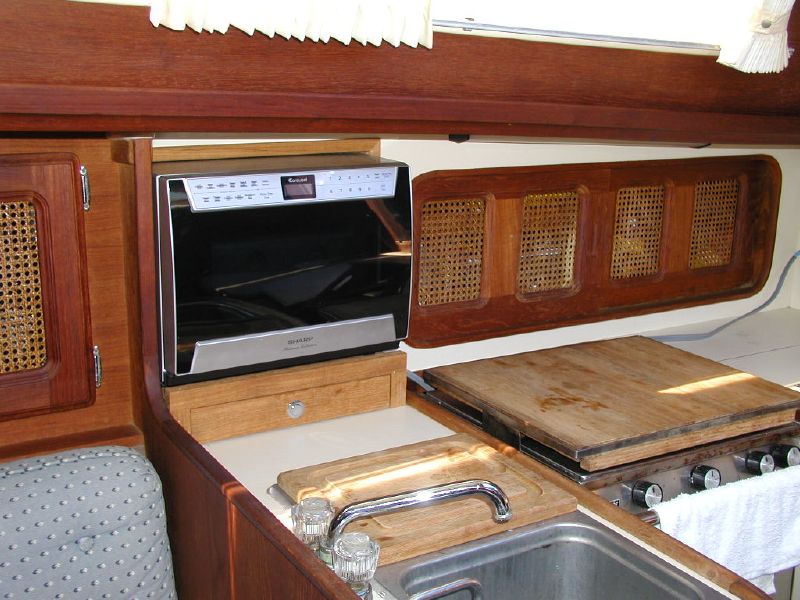Refrigeration
There are several places people have put the compressor units for refrigeration. The first picture is a 20 year old 110 volt & 12 volt unit on a shelf against the hull in the starboard cockpit locker on Vanishing Animal. The next two are a new compressor Harry Farrell put in the starboard stern lazerette.



Click Pics to enlarge.
Return to Maintenance Menu
Home Page Menu
Pressure Water Systems
Tuesday, November 03, 1998 10:01 AM
I am living aboard my Islander 36 in Port Townsend, WA. I'm from So. Cal originally. I've been living aboard for about five years now but it's much cooler here. I've installed a Dickinson diesel heater, and for the first time, I'm missing having a pressure hot water system and am making it my winter project.
I'm trying to decide on a conventional or instant water heater. (I have propane aboard now) Any suggestions from anyone with systems on board? What about the size of the heater. Is 6 gallons enough? I live alone here.
I have owned this boat since 1982. It's my first boat and I have no intentions of moving up or selling her. I've raced, crused (sic) and lived aboard successfully. These are great all around boats.
Lawrence Hillman, lhillman@olypen.com
Lawrence,
Many of the boats have a 5-6 gallon tank mounted, or rather "hung", beneath the cockpit floor, about directly over the prop shaft stuffing box. The typical rig has the engine cooling water circulate through it to heat water while under power (or charging batteries), and also a 110 volt heating element which works any time the boat is plugged in to shore power. That would seem to suit your situation well. About the only drawback is that hot water gets to the galley sink quickly, but takes a while, and uses a bit of water, to get hot water to the head. I'm assuming you're tied to a dock so water use should not be a big problem. We find that if running under engine for more than 30 minutes, the water stays warm even overnight. You might check your favorite marine catalog for units that fit this description.
Like Gary, mine is a 1973 vintage, and though showing some rust, it keeps on working for the 20 years I've had the boat!
Rick
Return to Maintenance Menu
Home Page Menu
Microwave Placement
A number of boats have put microwaves aboard. Most are only used when attached to shore power. A typical location is the aft end of the starboard upper bunk. Here's a description of Don Henderson's installation on Kindred Spirits, and pictures of Harry Farrell's aboard and Steven Harrington's aboard Ciara.
There have been a number of our group that have focused on Microwave
locations/installations. I believe most were relating to post 1978
Islanders, with the six bed configuration and an extensive “bin” over the
starboard settee.
“Kindred Spirits” is the older 1976 configuration with the bunk beds on the
starboard side. Since the “upper berth” is never used, I decided to use the
space (originally) for a bookshelf -- and more recently, expanded the shelf
space to accommodate a Microwave. (See pictures). The back of the settee
still swings up to allow for utilization of the lower bunk.
Biggest challenge was to find a Micro unit that would fit, given the
headliner clearance. After considerable shopping, I found that the “low
cost” units available at COSTCO, Sears, et.al were too big. Finally
purchase an ORIGO (made in Sweden, sold by West Marine) that was “just
right”. After building the “shelf” unit, the Microwave was secured with an
aluminum “band” that encompases the unit from forward to aft. The
“fiddles” used for the shelf were from W Marina (stock stuff). While this
is a 110 V unit, it will operate on an Inverter when shore power not
available. Total cost (no labor -- I’m free): Shelf configuration (4x8 ft
slab of Marine 3/4 in. Plywood; teak facings etc, around $150 -- Origo
Micowe around $130).
Don Henderson
“Kindred Spirits”

Kindred Spirits |

Pacific High |

Ciara |
Return to Maintenance Menu
Home Page Menu
Alcohol Stove Pressure
Ever get tired of running out of alcohol pressure on a rainy day, when guests are sitting on the cockpit locker, or the other watch is fighting a spinnaker death roll? Here's a way that the galley slave can keep on cookin' without disturbing a swab on deck.
The solution is to put a pressure gauge and air pump switch down below. The key part is a 12 volt air pump (the kind they sell for cars and inflating footballs). We got this one for $15 at Target. Cut off the cigarette lighter plug and wire it into a push-button switch to get 12 volts. The hose end has a fitting for a tire valve stem - just like the one on your alcohol tank. The only problem is that if left permanently on the valve stem, the vale is always compressed and there is a slow leak to let the pressure back out. Thus a small needle valve is added to the system. The last part is a gauge to read the pressure below. The gauge and needle valve are connected to the tank with 1/4 inch copper tubing. The whole setup cost about $35.
The first picture is how it looks below mounted on the aft wall of the galley behind the sink. The second picture is the pump and piping viewed looking forward into the cockpit locker.


Click Pics for full screen view.
Return to Maintenance Menu
Home Page Menu
CNG Availability
11/03/98 04:42:02 PM GMT
Well, it's been 4 years since I needed to refill my CNG tanks for cooking (The wonders of the microwave oven), and the place I had them filled last time is no longer there. Does anyone still sell CNG? Is there a place on the west side of the bay?
Thanks, Brian Jacobs
Replies:
Skipper Wall & Bob Englehart - Svensen's in Alameda carries CNG
Steve Schneider - My source for CNG is the gas dock in Sausalito, near West Marine and next to Caruso's. Accessible by car or boat. They have exchange cylinders for $16.00
plus tax. If you do not have the little brass fill cap with your existing
cylinder, it costs an additional $5.00. Phone is 415-332-3500. Check it out.
Mike Reed, Bellingham, WA - CNG is available in the Seattle/Puget Sound area for those of you who are interested. Sure Marine in Seattle is a supplier of not only CNG refills
but also most, if not all, of the parts and accessories you may need for
your stove/heaters. They're a great source of info, parts and supplies for
other fuels as well. CNG is also available in Friday Harbor, Anacortes and
La Conner. I use CNG for my stove/oven as well as for a Paloma water heater and am
very happy with it.
Its much harder to find CNG for marine use in Canada even though they use
it in cars, trucks and busses.
Frosty Foster - Can't be of much help with the Bay Area, but if anybody on the list sails on
Newport Bay, CNG exchanges are available at Hill's Chevron, next to the Pavillion.
Joe Thon - In the Rhode Island area there are still several places selling CNG. It may be
somewhat of a trip from the Frisco area, but there is some great sailing here
in the summer months. Has anyone investigated the possibility of simply
converting the current burner elements over to LPG jetted units? This change
would allow us to continue with the same stove/oven, by changing out the
burners, lines, and tanks, then adding a LPG solenoid.
Paul Johnson, Alaska - While in the Seattle area, I switched CNG bottles with SafeGas. I now own my own bottles, have all the testing done, and pay 5 bucks per refill at a place that sells CNG to motor vehicles here in Anchorage. I've had this good deal for over ten years. Hope they never go out of business.







